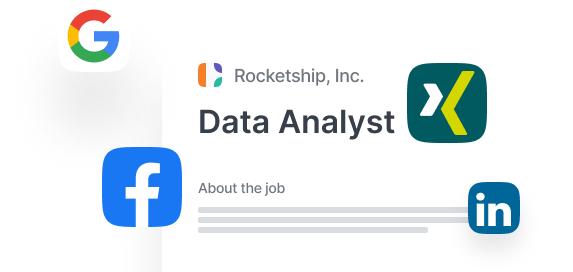Glossary: HR & Recruiting Definitions
What is blind hiring
Blind hiring, or blind recruitment, refers to the act of reducing bias in the hiring process by hiding parts of information about a job candidate. This can include information such as a candidate’s name, age, and gender. An effective blind hiring process can help you hire better and more fairly.
Blind hiring definition
Blind hiring, also called blind recruiting, involves any steps taken by a hiring manager or recruiter to hide candidate information to reduce potential bias. When blind hiring, any personal details that are not relevant to the candidate’s suitability for a role, but that might (subconsciously) influence the hiring decision, are taken out of the process.
The most common places where information is left out are in candidate applications (most notably through blind or anonymized resumes), but some companies even conduct blind interviews to prevent bias as much as possible.
The goal is to create a fairer process in which candidates are selected based on their skills and relevant experience rather than on unrelated traits.
For example, if a woman wears a hijab on the photo on their CV, the hiring manager of the company could disqualify the candidate because of a certain (unconscious) bias toward Muslim women. If a profile photo wasn’t required for the CV, the candidate might have made it through to the first stage of the interview process.
The woman might have been the best possible candidate for the job, only to be rejected straight away because of a bias-prone hiring process. That’s where blind hiring comes in as a better alternative to give everyone a fairer chance throughout the recruitment process.
Blind hiring process best practices
Implementing a blind hiring process involves taking certain steps to reduce the chance of potential biases guiding and influencing hiring decisions. The steps listed below are generally included in a blind hiring process and aim to anonymise applicants as much as possible, for as long as possible.
Note that these steps are preceded by other diversity, equity, and inclusion (DEI) methods, including:
- Using inclusive language in your job descriptions
- Posting job ads on multiple job boards to reach a broader audience
- Working on your employer branding to reflect your commitment to DEI
- Shifting your mindset to hiring for culture add rather than cultural fit
Define a goal
As with most organisational processes, it’s important to start by setting a clear goal. Why are you implementing a blind hiring process, and what is it you want to achieve by adapting your recruitment practices like this?
This will help you keep track of whether your blind recruiting efforts are actually having the desired results.
For instance, your blind hiring goal could be to reduce the gap between the number of women versus the number of men working in your Technology team by 10% over the course of 6 months. A clear and measurable goal like this helps you more easily keep track of the progress you’re making.
Decide on blind hiring process criteria
Next, you should determine what information is relevant (and what isn’t) for the hiring process. Anything that is not relevant to assessing a candidate’s fittingness for the role should be excluded from resumes, applications, and other steps of the process where possible.
This often starts by anonymizing the resumes of candidates and filtering out what is clearly not essential. In most cases, any type of demographic data will be irrelevant to a candidate’s suitability for the job. Some common factors to strip from your hiring process:
- Name: Studies have shown that “white-sounding” names tend to receive more callbacks compared to “black-sounding” names. Similarly, men are generally more likely to be hired than women even if their qualifications are identical.
- Photo: It is still common in many countries for applicants to include a picture of themselves in their CV or resume. However, someone’s physical appearance can (subconsciously) influence a hiring manager’s decision to hire or not.
- Dates: If you know when someone attended a school, you can (roughly) deduce their age. Studies have shown this can result in ageism and related bias (even though companies shouldn’t shy away from hiring older employees in the first place).
- Location: Where someone lives can not only give you an indication of their income, but also of their ethnic background and age. The only way location has a place in a blind hiring process is when asking if a candidate is eligible to work in the area your business is located, but they don’t have to share their address for that.
- Education: Aside from hiding the dates someone attended school or university, you can also hide the name of the institution. Having gone to a prestigious university doesn’t necessarily mean the candidate is great at their job. It can, however, indicate economic background, ethnic background, and geographical location.
- Language: Unless essential for the job role (e.g. when hiring a Translator or a Tour Guide) you should strip language information. This indicates nationality or cultural background, which can result in biased decisions.
- Writing style: The way someone’s CV or cover letter is written can tell you something about the candidate’s background, which can result in bias. This part can be more difficult to filter out of the hiring process (more on this below).
Aside from hiding these pieces of information in your recruitment process, you should also consider what skills are truly essential for the job, and which ones aren’t. This will most likely be a mix of both soft and hard skills.
To learn more about skill-based hiring rather than role-based hiring (and interviewing), check out our article on hiring for roles vs. hiring for skills.
There are several methods that you can use to filter out all this information, including using paid tools like Blendoor.
Alternatively, you can solve this manually and internally, for example by:
- Having someone other than the hiring manager filter through the CVs first to establish a fairer shortlisting process.
- Stating your hiring criteria clearly in your job advert, so candidates already filter out some information for you.
- Creating a custom application form on your website (or in JOIN’s Build feature) rather than having candidates send over their resume or cover letter. This can also simultaneously help you speed up your candidate screening process.
- Implementing an inclusive screening process. This can include a pre-assessment test based on skills, a personality type test, or having candidates fill out pre-screening questions.
Note that this pre-screening should never include looking someone up on LinkedIn or other social media. Not only will this make you much more prone to bias, but it can in some cases even violate data privacy regulations (like GDPR).
Stay blind for as long as possible
The longer you can keep the hiring process blind and anonymous, the more you will reduce subconscious biases influencing decisions.
That’s why some companies have introduced blind interviews as part of their interview process. This could be in the form of sending interview questions rather than scheduling a face-to-face interview. Another method is by holding a phone interview first, although someone’s voice can already signal a certain background.
Do note that these methods may work as an extra anti-bias layer within your interview process, but they probably can’t replace the process. Meaning, at the end of the day, you will have to have a face-to-face interview with a potential candidate to get to know them. But adding a blind interview step can help reduce potential bias earlier on in the process.
Measure, analyse, and reflect
Lastly, you should continuously keep track of your hiring efforts and whether you are reaching your goals:
- Do you notice any changes due to the blind hiring process?
- Have you eliminated certain biases from the decision-making process?
- Is there still more that you can do or anything that might be improved?
In addition, you should simultaneously keep expanding your efforts outside of hiring as well. Ultimately, your blind hiring process should become part of your company’s holistic diversity recruiting process.
Simplify your hiring process and workflow
Understand how to create job ads that actually work. Leverage winning strategies to best promote ads. Find the ideal candidate faster.
Already have an account? Sign in
Similar terms
Related to “B”
 Build compelling job ads
Build compelling job ads
 Promote ads on job search sites
Promote ads on job search sites
 Manage candidates easy
Manage candidates easy



